Risk Management Plan for ATA’s East Timor Solar Project
VerifiedAdded on 2023/04/10
|8
|1721
|110
AI Summary
This document provides a risk management plan for ATA’s East Timor Solar Project, including risk identification, analysis, and response strategies. The project background, need for risk management, stakeholder engagement and management, and risk matrix are also discussed. The document is relevant for project management and risk management courses.
Contribute Materials
Your contribution can guide someone’s learning journey. Share your
documents today.
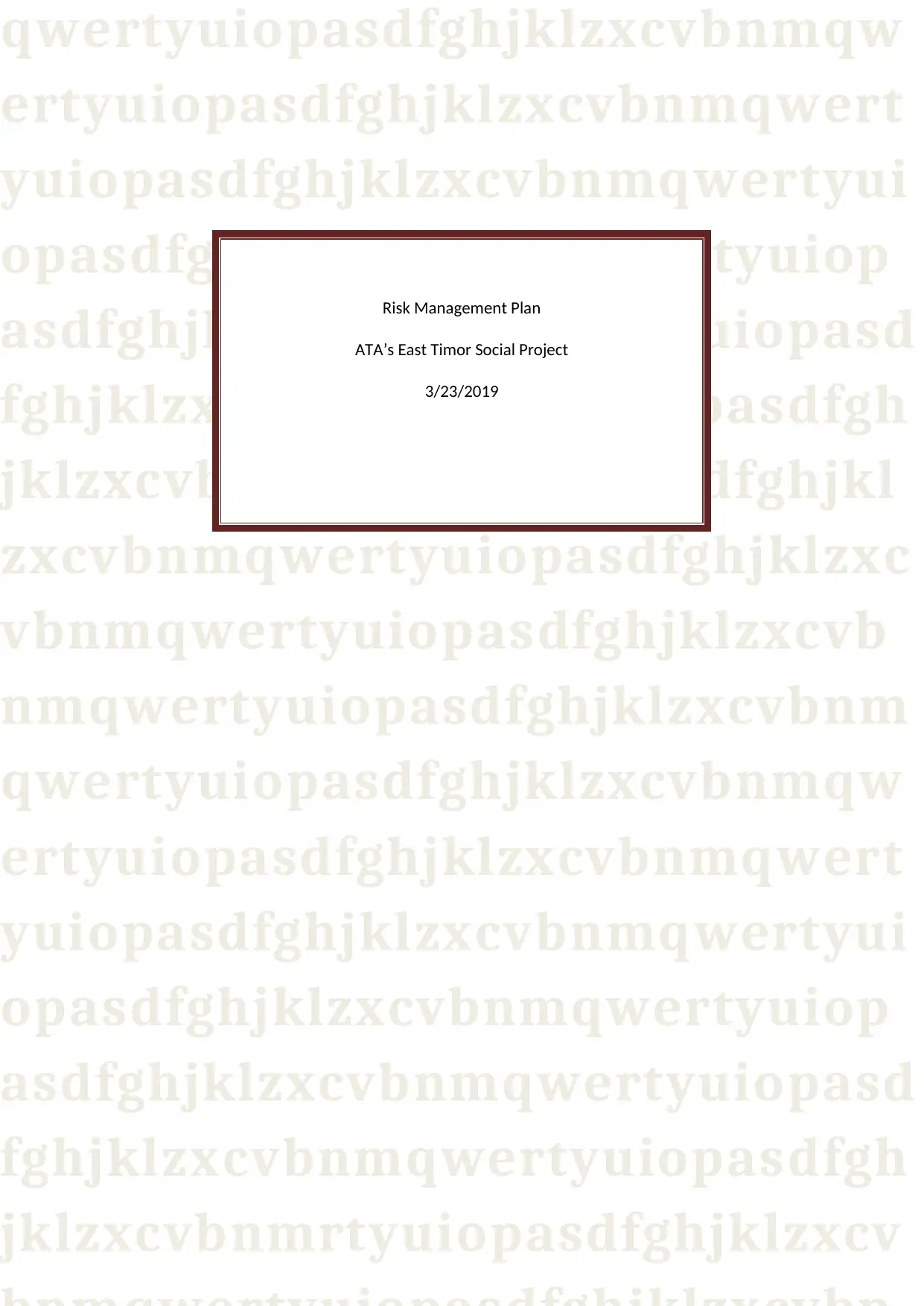
qwertyuiopasdfghjklzxcvbnmqw
ertyuiopasdfghjklzxcvbnmqwert
yuiopasdfghjklzxcvbnmqwertyui
opasdfghjklzxcvbnmqwertyuiop
asdfghjklzxcvbnmqwertyuiopasd
fghjklzxcvbnmqwertyuiopasdfgh
jklzxcvbnmqwertyuiopasdfghjkl
zxcvbnmqwertyuiopasdfghjklzxc
vbnmqwertyuiopasdfghjklzxcvb
nmqwertyuiopasdfghjklzxcvbnm
qwertyuiopasdfghjklzxcvbnmqw
ertyuiopasdfghjklzxcvbnmqwert
yuiopasdfghjklzxcvbnmqwertyui
opasdfghjklzxcvbnmqwertyuiop
asdfghjklzxcvbnmqwertyuiopasd
fghjklzxcvbnmqwertyuiopasdfgh
jklzxcvbnmrtyuiopasdfghjklzxcv
Risk Management Plan
ATA’s East Timor Social Project
3/23/2019
ertyuiopasdfghjklzxcvbnmqwert
yuiopasdfghjklzxcvbnmqwertyui
opasdfghjklzxcvbnmqwertyuiop
asdfghjklzxcvbnmqwertyuiopasd
fghjklzxcvbnmqwertyuiopasdfgh
jklzxcvbnmqwertyuiopasdfghjkl
zxcvbnmqwertyuiopasdfghjklzxc
vbnmqwertyuiopasdfghjklzxcvb
nmqwertyuiopasdfghjklzxcvbnm
qwertyuiopasdfghjklzxcvbnmqw
ertyuiopasdfghjklzxcvbnmqwert
yuiopasdfghjklzxcvbnmqwertyui
opasdfghjklzxcvbnmqwertyuiop
asdfghjklzxcvbnmqwertyuiopasd
fghjklzxcvbnmqwertyuiopasdfgh
jklzxcvbnmrtyuiopasdfghjklzxcv
Risk Management Plan
ATA’s East Timor Social Project
3/23/2019
Secure Best Marks with AI Grader
Need help grading? Try our AI Grader for instant feedback on your assignments.
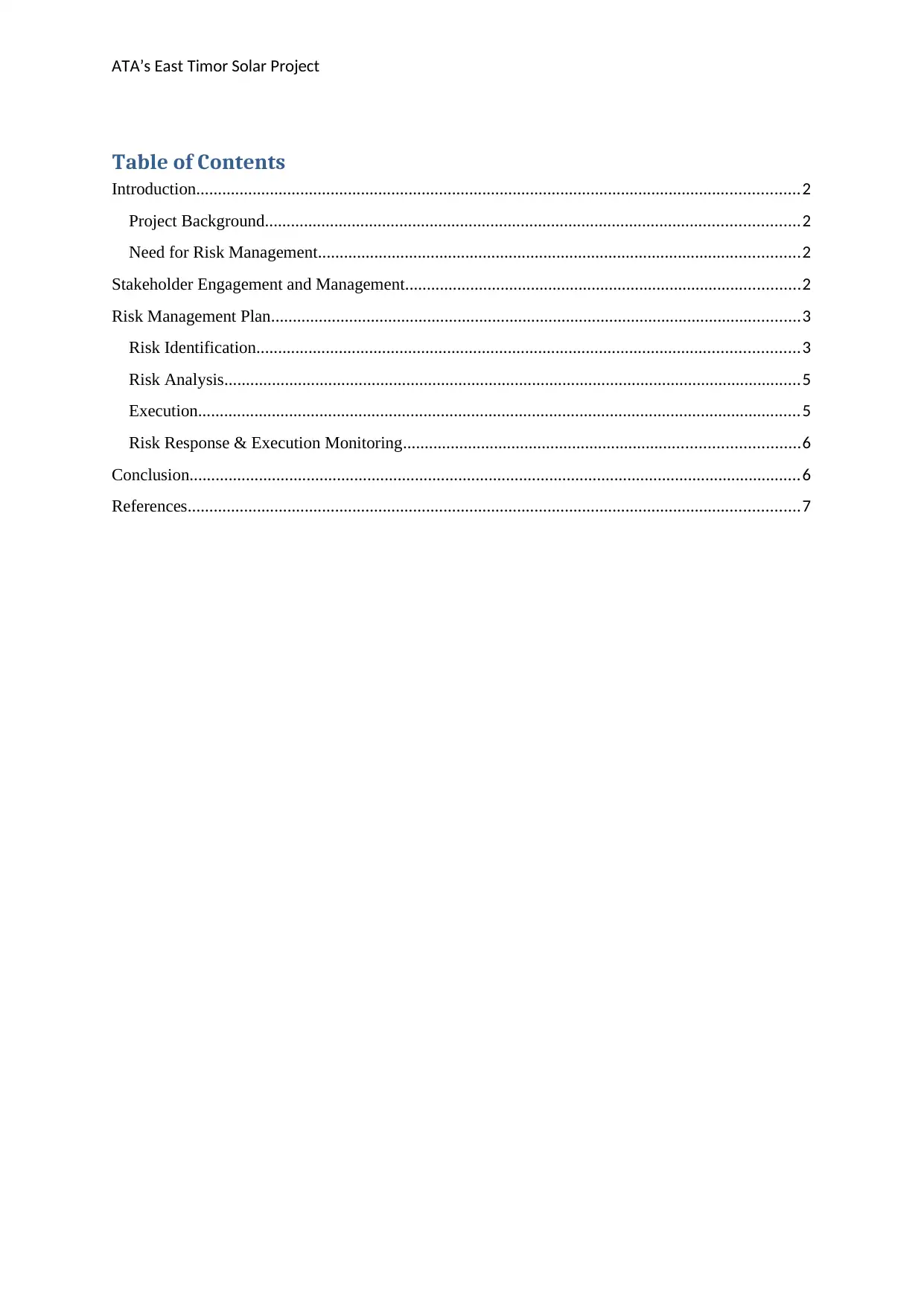
ATA’s East Timor Solar Project
Table of Contents
Introduction...........................................................................................................................................2
Project Background...........................................................................................................................2
Need for Risk Management...............................................................................................................2
Stakeholder Engagement and Management...........................................................................................2
Risk Management Plan..........................................................................................................................3
Risk Identification.............................................................................................................................3
Risk Analysis.....................................................................................................................................5
Execution...........................................................................................................................................5
Risk Response & Execution Monitoring...........................................................................................6
Conclusion.............................................................................................................................................6
References.............................................................................................................................................7
Table of Contents
Introduction...........................................................................................................................................2
Project Background...........................................................................................................................2
Need for Risk Management...............................................................................................................2
Stakeholder Engagement and Management...........................................................................................2
Risk Management Plan..........................................................................................................................3
Risk Identification.............................................................................................................................3
Risk Analysis.....................................................................................................................................5
Execution...........................................................................................................................................5
Risk Response & Execution Monitoring...........................................................................................6
Conclusion.............................................................................................................................................6
References.............................................................................................................................................7
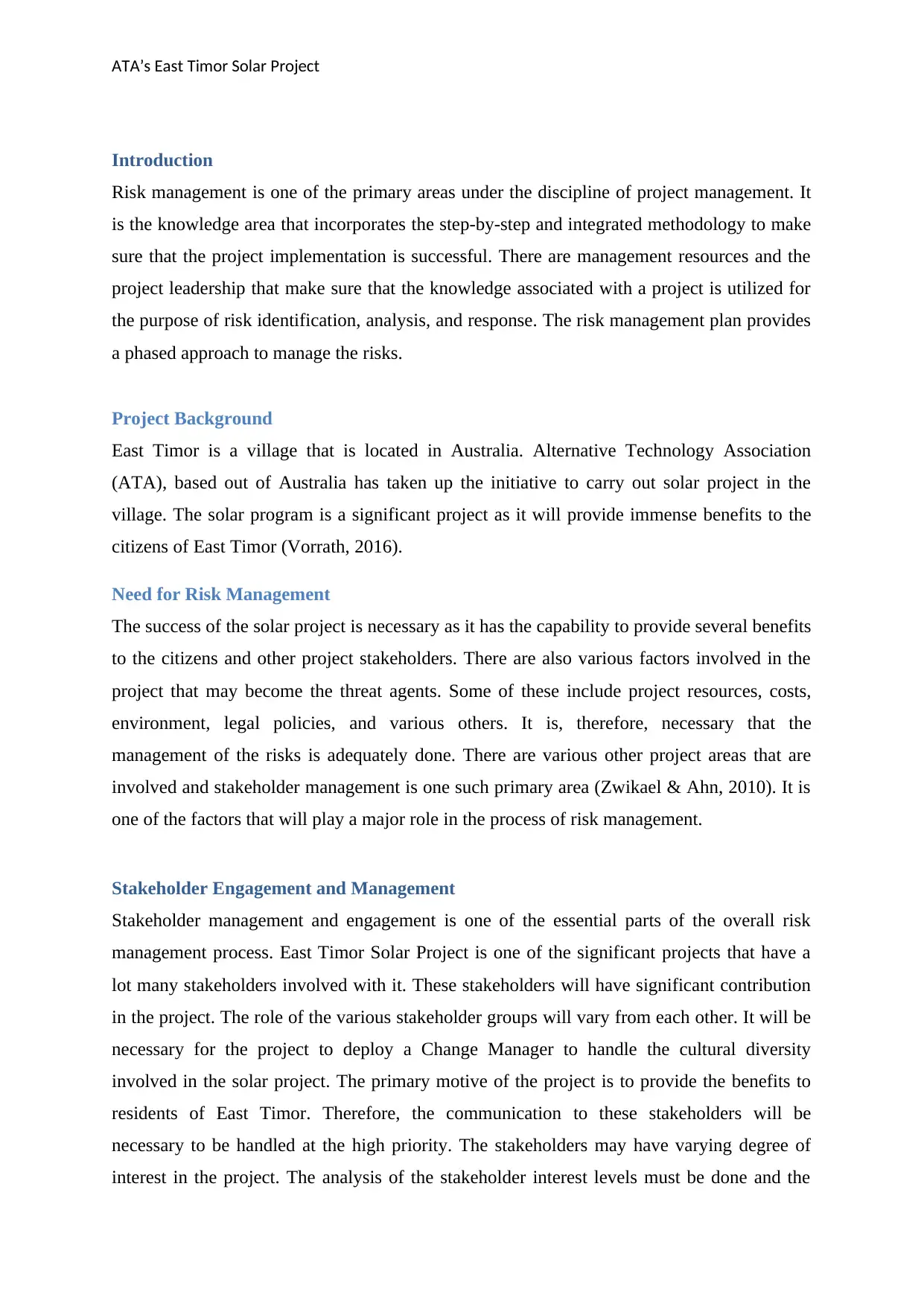
ATA’s East Timor Solar Project
Introduction
Risk management is one of the primary areas under the discipline of project management. It
is the knowledge area that incorporates the step-by-step and integrated methodology to make
sure that the project implementation is successful. There are management resources and the
project leadership that make sure that the knowledge associated with a project is utilized for
the purpose of risk identification, analysis, and response. The risk management plan provides
a phased approach to manage the risks.
Project Background
East Timor is a village that is located in Australia. Alternative Technology Association
(ATA), based out of Australia has taken up the initiative to carry out solar project in the
village. The solar program is a significant project as it will provide immense benefits to the
citizens of East Timor (Vorrath, 2016).
Need for Risk Management
The success of the solar project is necessary as it has the capability to provide several benefits
to the citizens and other project stakeholders. There are also various factors involved in the
project that may become the threat agents. Some of these include project resources, costs,
environment, legal policies, and various others. It is, therefore, necessary that the
management of the risks is adequately done. There are various other project areas that are
involved and stakeholder management is one such primary area (Zwikael & Ahn, 2010). It is
one of the factors that will play a major role in the process of risk management.
Stakeholder Engagement and Management
Stakeholder management and engagement is one of the essential parts of the overall risk
management process. East Timor Solar Project is one of the significant projects that have a
lot many stakeholders involved with it. These stakeholders will have significant contribution
in the project. The role of the various stakeholder groups will vary from each other. It will be
necessary for the project to deploy a Change Manager to handle the cultural diversity
involved in the solar project. The primary motive of the project is to provide the benefits to
residents of East Timor. Therefore, the communication to these stakeholders will be
necessary to be handled at the high priority. The stakeholders may have varying degree of
interest in the project. The analysis of the stakeholder interest levels must be done and the
Introduction
Risk management is one of the primary areas under the discipline of project management. It
is the knowledge area that incorporates the step-by-step and integrated methodology to make
sure that the project implementation is successful. There are management resources and the
project leadership that make sure that the knowledge associated with a project is utilized for
the purpose of risk identification, analysis, and response. The risk management plan provides
a phased approach to manage the risks.
Project Background
East Timor is a village that is located in Australia. Alternative Technology Association
(ATA), based out of Australia has taken up the initiative to carry out solar project in the
village. The solar program is a significant project as it will provide immense benefits to the
citizens of East Timor (Vorrath, 2016).
Need for Risk Management
The success of the solar project is necessary as it has the capability to provide several benefits
to the citizens and other project stakeholders. There are also various factors involved in the
project that may become the threat agents. Some of these include project resources, costs,
environment, legal policies, and various others. It is, therefore, necessary that the
management of the risks is adequately done. There are various other project areas that are
involved and stakeholder management is one such primary area (Zwikael & Ahn, 2010). It is
one of the factors that will play a major role in the process of risk management.
Stakeholder Engagement and Management
Stakeholder management and engagement is one of the essential parts of the overall risk
management process. East Timor Solar Project is one of the significant projects that have a
lot many stakeholders involved with it. These stakeholders will have significant contribution
in the project. The role of the various stakeholder groups will vary from each other. It will be
necessary for the project to deploy a Change Manager to handle the cultural diversity
involved in the solar project. The primary motive of the project is to provide the benefits to
residents of East Timor. Therefore, the communication to these stakeholders will be
necessary to be handled at the high priority. The stakeholders may have varying degree of
interest in the project. The analysis of the stakeholder interest levels must be done and the
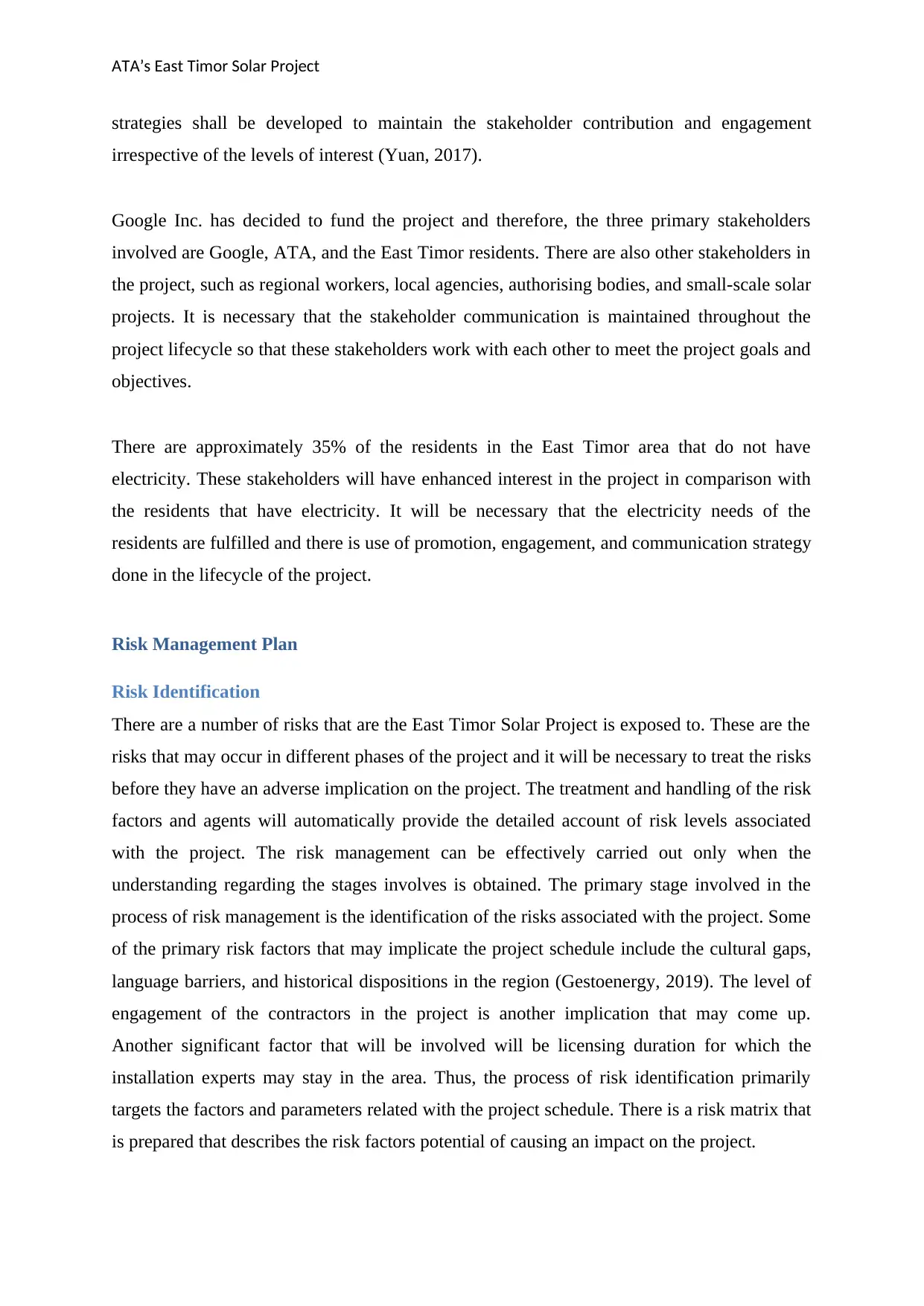
ATA’s East Timor Solar Project
strategies shall be developed to maintain the stakeholder contribution and engagement
irrespective of the levels of interest (Yuan, 2017).
Google Inc. has decided to fund the project and therefore, the three primary stakeholders
involved are Google, ATA, and the East Timor residents. There are also other stakeholders in
the project, such as regional workers, local agencies, authorising bodies, and small-scale solar
projects. It is necessary that the stakeholder communication is maintained throughout the
project lifecycle so that these stakeholders work with each other to meet the project goals and
objectives.
There are approximately 35% of the residents in the East Timor area that do not have
electricity. These stakeholders will have enhanced interest in the project in comparison with
the residents that have electricity. It will be necessary that the electricity needs of the
residents are fulfilled and there is use of promotion, engagement, and communication strategy
done in the lifecycle of the project.
Risk Management Plan
Risk Identification
There are a number of risks that are the East Timor Solar Project is exposed to. These are the
risks that may occur in different phases of the project and it will be necessary to treat the risks
before they have an adverse implication on the project. The treatment and handling of the risk
factors and agents will automatically provide the detailed account of risk levels associated
with the project. The risk management can be effectively carried out only when the
understanding regarding the stages involves is obtained. The primary stage involved in the
process of risk management is the identification of the risks associated with the project. Some
of the primary risk factors that may implicate the project schedule include the cultural gaps,
language barriers, and historical dispositions in the region (Gestoenergy, 2019). The level of
engagement of the contractors in the project is another implication that may come up.
Another significant factor that will be involved will be licensing duration for which the
installation experts may stay in the area. Thus, the process of risk identification primarily
targets the factors and parameters related with the project schedule. There is a risk matrix that
is prepared that describes the risk factors potential of causing an impact on the project.
strategies shall be developed to maintain the stakeholder contribution and engagement
irrespective of the levels of interest (Yuan, 2017).
Google Inc. has decided to fund the project and therefore, the three primary stakeholders
involved are Google, ATA, and the East Timor residents. There are also other stakeholders in
the project, such as regional workers, local agencies, authorising bodies, and small-scale solar
projects. It is necessary that the stakeholder communication is maintained throughout the
project lifecycle so that these stakeholders work with each other to meet the project goals and
objectives.
There are approximately 35% of the residents in the East Timor area that do not have
electricity. These stakeholders will have enhanced interest in the project in comparison with
the residents that have electricity. It will be necessary that the electricity needs of the
residents are fulfilled and there is use of promotion, engagement, and communication strategy
done in the lifecycle of the project.
Risk Management Plan
Risk Identification
There are a number of risks that are the East Timor Solar Project is exposed to. These are the
risks that may occur in different phases of the project and it will be necessary to treat the risks
before they have an adverse implication on the project. The treatment and handling of the risk
factors and agents will automatically provide the detailed account of risk levels associated
with the project. The risk management can be effectively carried out only when the
understanding regarding the stages involves is obtained. The primary stage involved in the
process of risk management is the identification of the risks associated with the project. Some
of the primary risk factors that may implicate the project schedule include the cultural gaps,
language barriers, and historical dispositions in the region (Gestoenergy, 2019). The level of
engagement of the contractors in the project is another implication that may come up.
Another significant factor that will be involved will be licensing duration for which the
installation experts may stay in the area. Thus, the process of risk identification primarily
targets the factors and parameters related with the project schedule. There is a risk matrix that
is prepared that describes the risk factors potential of causing an impact on the project.
Secure Best Marks with AI Grader
Need help grading? Try our AI Grader for instant feedback on your assignments.
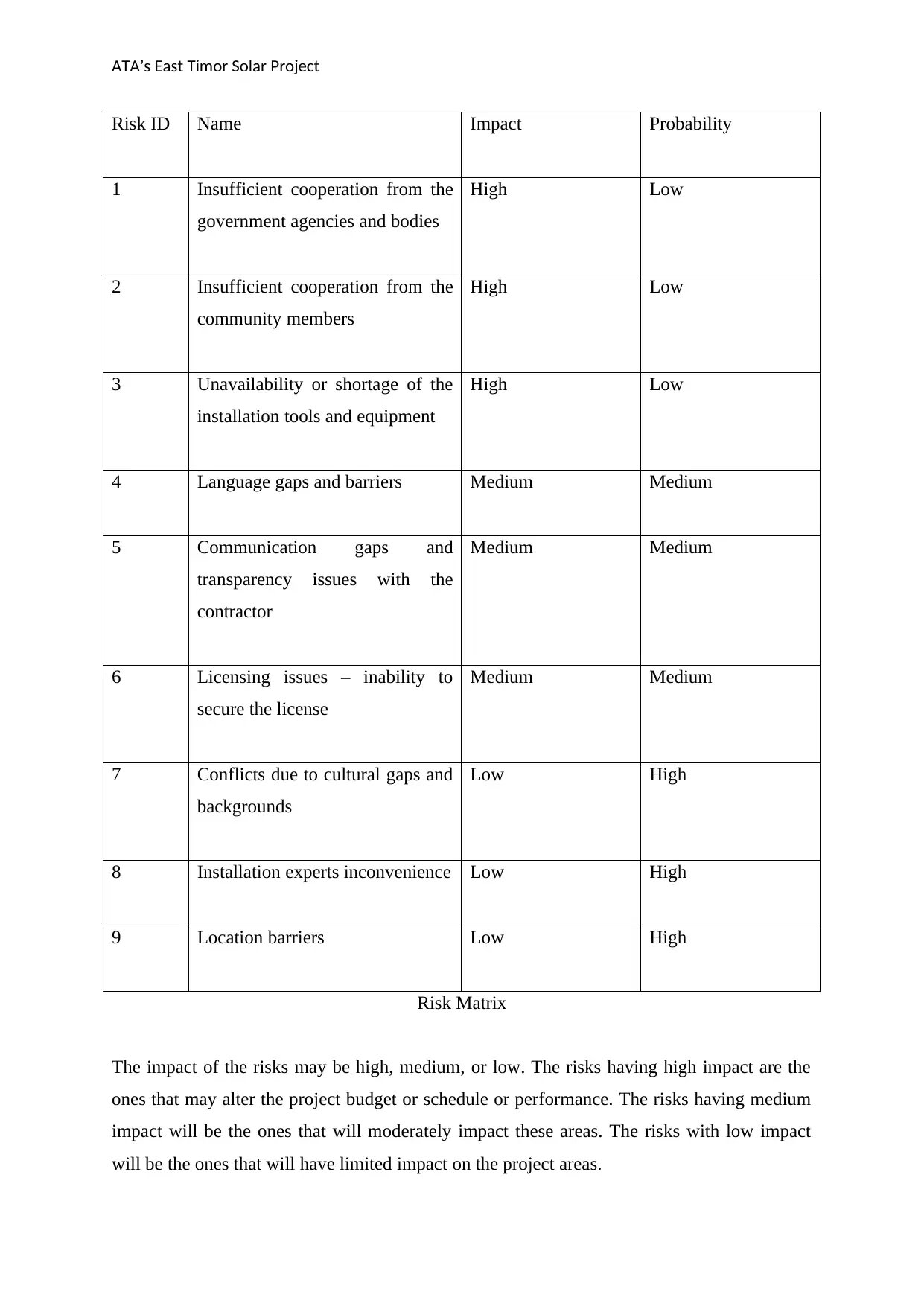
ATA’s East Timor Solar Project
Risk ID Name Impact Probability
1 Insufficient cooperation from the
government agencies and bodies
High Low
2 Insufficient cooperation from the
community members
High Low
3 Unavailability or shortage of the
installation tools and equipment
High Low
4 Language gaps and barriers Medium Medium
5 Communication gaps and
transparency issues with the
contractor
Medium Medium
6 Licensing issues – inability to
secure the license
Medium Medium
7 Conflicts due to cultural gaps and
backgrounds
Low High
8 Installation experts inconvenience Low High
9 Location barriers Low High
Risk Matrix
The impact of the risks may be high, medium, or low. The risks having high impact are the
ones that may alter the project budget or schedule or performance. The risks having medium
impact will be the ones that will moderately impact these areas. The risks with low impact
will be the ones that will have limited impact on the project areas.
Risk ID Name Impact Probability
1 Insufficient cooperation from the
government agencies and bodies
High Low
2 Insufficient cooperation from the
community members
High Low
3 Unavailability or shortage of the
installation tools and equipment
High Low
4 Language gaps and barriers Medium Medium
5 Communication gaps and
transparency issues with the
contractor
Medium Medium
6 Licensing issues – inability to
secure the license
Medium Medium
7 Conflicts due to cultural gaps and
backgrounds
Low High
8 Installation experts inconvenience Low High
9 Location barriers Low High
Risk Matrix
The impact of the risks may be high, medium, or low. The risks having high impact are the
ones that may alter the project budget or schedule or performance. The risks having medium
impact will be the ones that will moderately impact these areas. The risks with low impact
will be the ones that will have limited impact on the project areas.
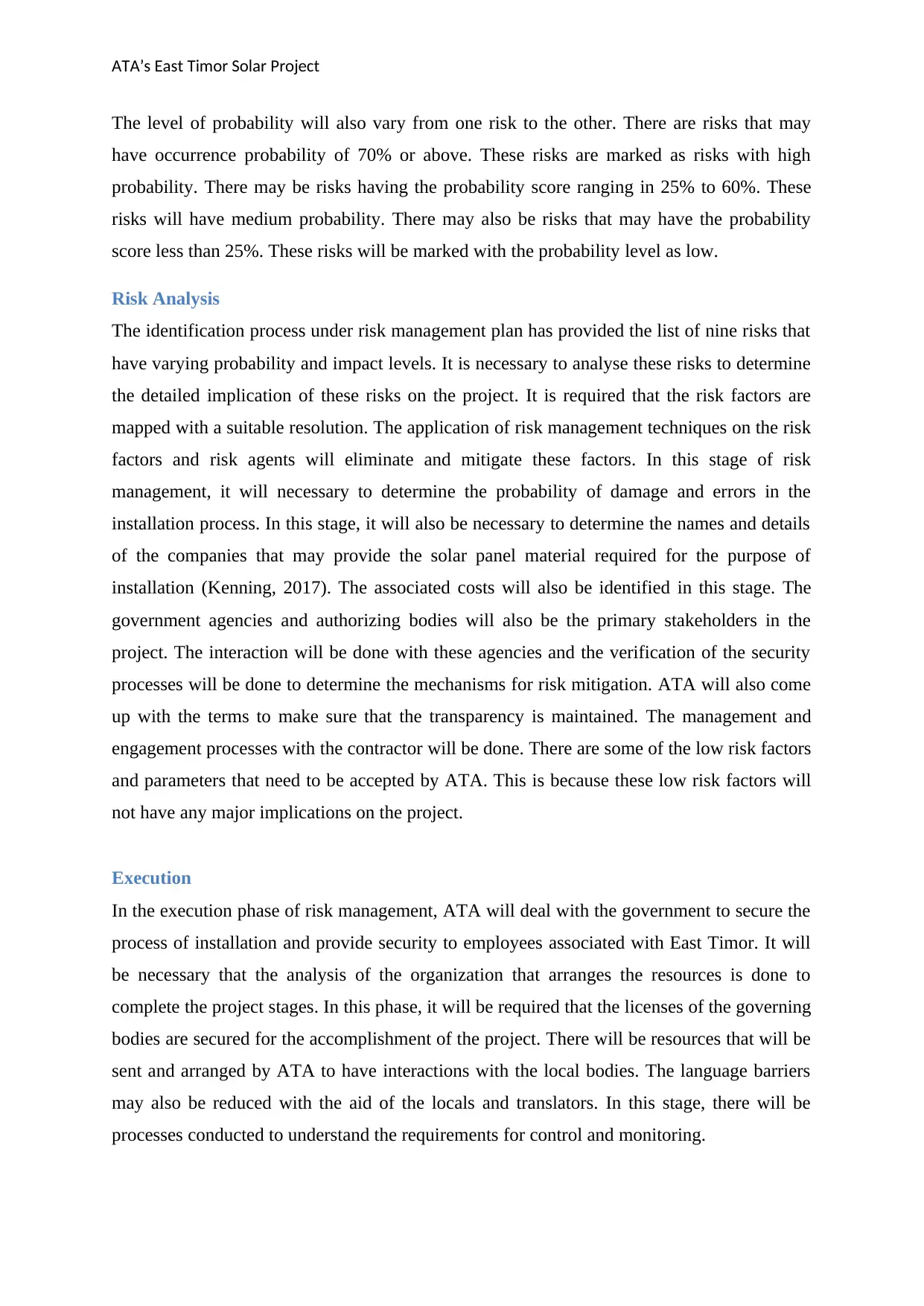
ATA’s East Timor Solar Project
The level of probability will also vary from one risk to the other. There are risks that may
have occurrence probability of 70% or above. These risks are marked as risks with high
probability. There may be risks having the probability score ranging in 25% to 60%. These
risks will have medium probability. There may also be risks that may have the probability
score less than 25%. These risks will be marked with the probability level as low.
Risk Analysis
The identification process under risk management plan has provided the list of nine risks that
have varying probability and impact levels. It is necessary to analyse these risks to determine
the detailed implication of these risks on the project. It is required that the risk factors are
mapped with a suitable resolution. The application of risk management techniques on the risk
factors and risk agents will eliminate and mitigate these factors. In this stage of risk
management, it will necessary to determine the probability of damage and errors in the
installation process. In this stage, it will also be necessary to determine the names and details
of the companies that may provide the solar panel material required for the purpose of
installation (Kenning, 2017). The associated costs will also be identified in this stage. The
government agencies and authorizing bodies will also be the primary stakeholders in the
project. The interaction will be done with these agencies and the verification of the security
processes will be done to determine the mechanisms for risk mitigation. ATA will also come
up with the terms to make sure that the transparency is maintained. The management and
engagement processes with the contractor will be done. There are some of the low risk factors
and parameters that need to be accepted by ATA. This is because these low risk factors will
not have any major implications on the project.
Execution
In the execution phase of risk management, ATA will deal with the government to secure the
process of installation and provide security to employees associated with East Timor. It will
be necessary that the analysis of the organization that arranges the resources is done to
complete the project stages. In this phase, it will be required that the licenses of the governing
bodies are secured for the accomplishment of the project. There will be resources that will be
sent and arranged by ATA to have interactions with the local bodies. The language barriers
may also be reduced with the aid of the locals and translators. In this stage, there will be
processes conducted to understand the requirements for control and monitoring.
The level of probability will also vary from one risk to the other. There are risks that may
have occurrence probability of 70% or above. These risks are marked as risks with high
probability. There may be risks having the probability score ranging in 25% to 60%. These
risks will have medium probability. There may also be risks that may have the probability
score less than 25%. These risks will be marked with the probability level as low.
Risk Analysis
The identification process under risk management plan has provided the list of nine risks that
have varying probability and impact levels. It is necessary to analyse these risks to determine
the detailed implication of these risks on the project. It is required that the risk factors are
mapped with a suitable resolution. The application of risk management techniques on the risk
factors and risk agents will eliminate and mitigate these factors. In this stage of risk
management, it will necessary to determine the probability of damage and errors in the
installation process. In this stage, it will also be necessary to determine the names and details
of the companies that may provide the solar panel material required for the purpose of
installation (Kenning, 2017). The associated costs will also be identified in this stage. The
government agencies and authorizing bodies will also be the primary stakeholders in the
project. The interaction will be done with these agencies and the verification of the security
processes will be done to determine the mechanisms for risk mitigation. ATA will also come
up with the terms to make sure that the transparency is maintained. The management and
engagement processes with the contractor will be done. There are some of the low risk factors
and parameters that need to be accepted by ATA. This is because these low risk factors will
not have any major implications on the project.
Execution
In the execution phase of risk management, ATA will deal with the government to secure the
process of installation and provide security to employees associated with East Timor. It will
be necessary that the analysis of the organization that arranges the resources is done to
complete the project stages. In this phase, it will be required that the licenses of the governing
bodies are secured for the accomplishment of the project. There will be resources that will be
sent and arranged by ATA to have interactions with the local bodies. The language barriers
may also be reduced with the aid of the locals and translators. In this stage, there will be
processes conducted to understand the requirements for control and monitoring.
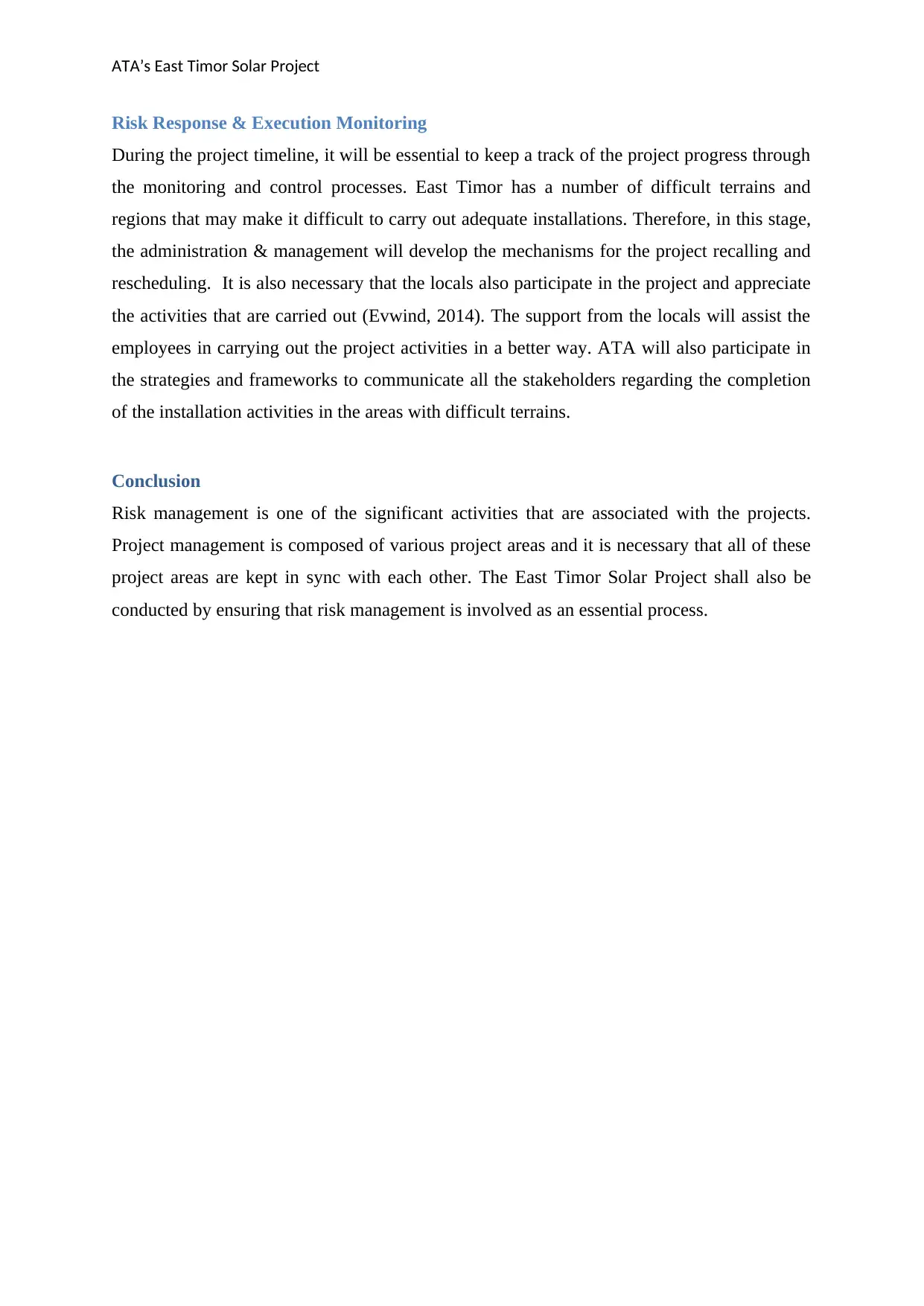
ATA’s East Timor Solar Project
Risk Response & Execution Monitoring
During the project timeline, it will be essential to keep a track of the project progress through
the monitoring and control processes. East Timor has a number of difficult terrains and
regions that may make it difficult to carry out adequate installations. Therefore, in this stage,
the administration & management will develop the mechanisms for the project recalling and
rescheduling. It is also necessary that the locals also participate in the project and appreciate
the activities that are carried out (Evwind, 2014). The support from the locals will assist the
employees in carrying out the project activities in a better way. ATA will also participate in
the strategies and frameworks to communicate all the stakeholders regarding the completion
of the installation activities in the areas with difficult terrains.
Conclusion
Risk management is one of the significant activities that are associated with the projects.
Project management is composed of various project areas and it is necessary that all of these
project areas are kept in sync with each other. The East Timor Solar Project shall also be
conducted by ensuring that risk management is involved as an essential process.
Risk Response & Execution Monitoring
During the project timeline, it will be essential to keep a track of the project progress through
the monitoring and control processes. East Timor has a number of difficult terrains and
regions that may make it difficult to carry out adequate installations. Therefore, in this stage,
the administration & management will develop the mechanisms for the project recalling and
rescheduling. It is also necessary that the locals also participate in the project and appreciate
the activities that are carried out (Evwind, 2014). The support from the locals will assist the
employees in carrying out the project activities in a better way. ATA will also participate in
the strategies and frameworks to communicate all the stakeholders regarding the completion
of the installation activities in the areas with difficult terrains.
Conclusion
Risk management is one of the significant activities that are associated with the projects.
Project management is composed of various project areas and it is necessary that all of these
project areas are kept in sync with each other. The East Timor Solar Project shall also be
conducted by ensuring that risk management is involved as an essential process.
Paraphrase This Document
Need a fresh take? Get an instant paraphrase of this document with our AI Paraphraser
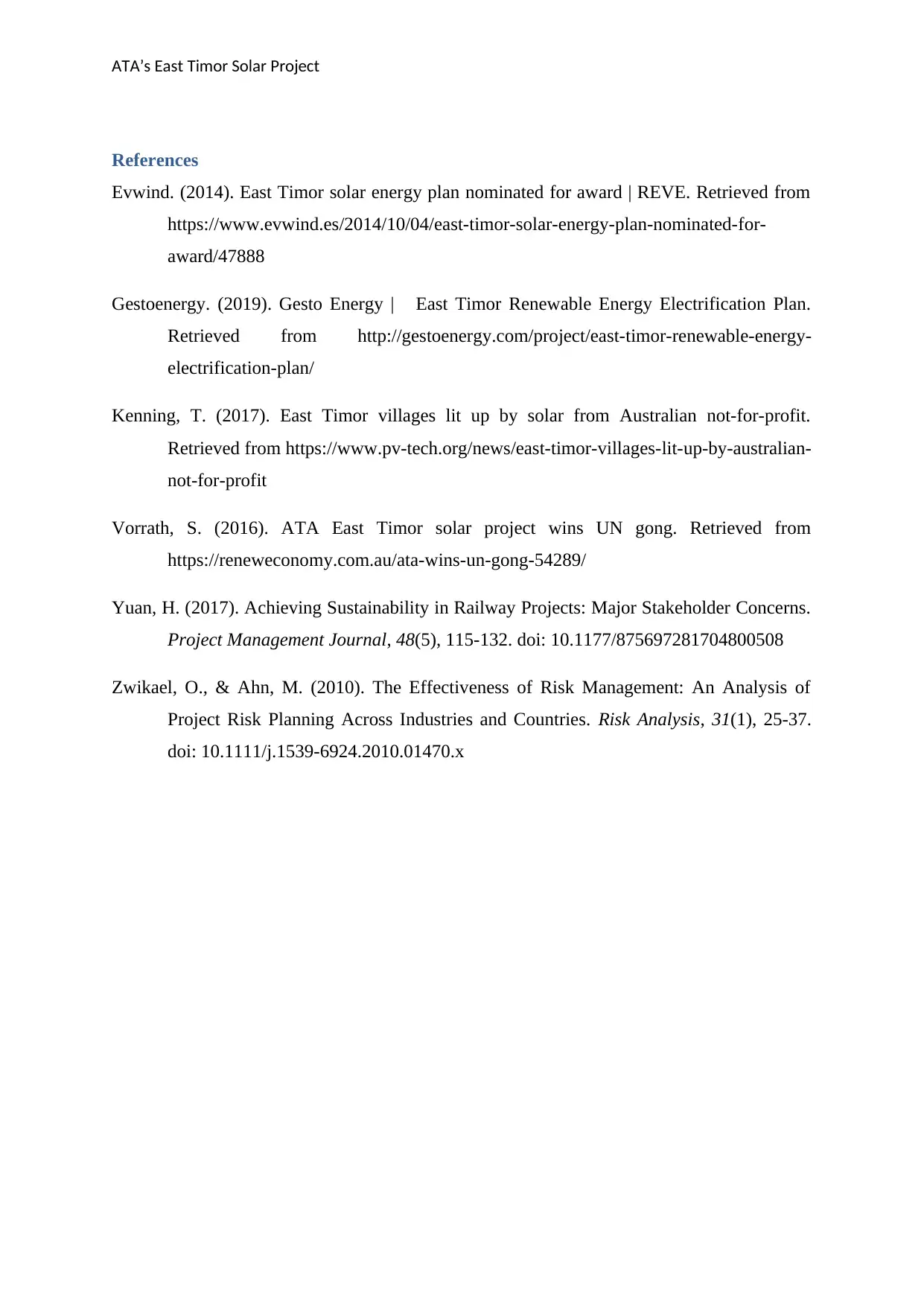
ATA’s East Timor Solar Project
References
Evwind. (2014). East Timor solar energy plan nominated for award | REVE. Retrieved from
https://www.evwind.es/2014/10/04/east-timor-solar-energy-plan-nominated-for-
award/47888
Gestoenergy. (2019). Gesto Energy | East Timor Renewable Energy Electrification Plan.
Retrieved from http://gestoenergy.com/project/east-timor-renewable-energy-
electrification-plan/
Kenning, T. (2017). East Timor villages lit up by solar from Australian not-for-profit.
Retrieved from https://www.pv-tech.org/news/east-timor-villages-lit-up-by-australian-
not-for-profit
Vorrath, S. (2016). ATA East Timor solar project wins UN gong. Retrieved from
https://reneweconomy.com.au/ata-wins-un-gong-54289/
Yuan, H. (2017). Achieving Sustainability in Railway Projects: Major Stakeholder Concerns.
Project Management Journal, 48(5), 115-132. doi: 10.1177/875697281704800508
Zwikael, O., & Ahn, M. (2010). The Effectiveness of Risk Management: An Analysis of
Project Risk Planning Across Industries and Countries. Risk Analysis, 31(1), 25-37.
doi: 10.1111/j.1539-6924.2010.01470.x
References
Evwind. (2014). East Timor solar energy plan nominated for award | REVE. Retrieved from
https://www.evwind.es/2014/10/04/east-timor-solar-energy-plan-nominated-for-
award/47888
Gestoenergy. (2019). Gesto Energy | East Timor Renewable Energy Electrification Plan.
Retrieved from http://gestoenergy.com/project/east-timor-renewable-energy-
electrification-plan/
Kenning, T. (2017). East Timor villages lit up by solar from Australian not-for-profit.
Retrieved from https://www.pv-tech.org/news/east-timor-villages-lit-up-by-australian-
not-for-profit
Vorrath, S. (2016). ATA East Timor solar project wins UN gong. Retrieved from
https://reneweconomy.com.au/ata-wins-un-gong-54289/
Yuan, H. (2017). Achieving Sustainability in Railway Projects: Major Stakeholder Concerns.
Project Management Journal, 48(5), 115-132. doi: 10.1177/875697281704800508
Zwikael, O., & Ahn, M. (2010). The Effectiveness of Risk Management: An Analysis of
Project Risk Planning Across Industries and Countries. Risk Analysis, 31(1), 25-37.
doi: 10.1111/j.1539-6924.2010.01470.x
1 out of 8
Related Documents
Your All-in-One AI-Powered Toolkit for Academic Success.
+13062052269
info@desklib.com
Available 24*7 on WhatsApp / Email
![[object Object]](/_next/static/media/star-bottom.7253800d.svg)
Unlock your academic potential
© 2024 | Zucol Services PVT LTD | All rights reserved.





